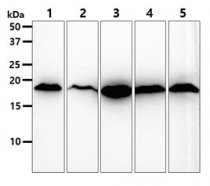ARG57160
anti-SOD1 antibody [6F1]
anti-SOD1 antibody [6F1] for Flow cytometry,Western blot and Human
Overview
| Product Description | Mouse Monoclonal antibody [6F1] recognizes SOD1 |
|---|---|
| Tested Reactivity | Hu |
| Tested Application | FACS, WB |
| Host | Mouse |
| Clonality | Monoclonal |
| Clone | 6F1 |
| Isotype | IgG1, kappa |
| Target Name | SOD1 |
| Antigen Species | Human |
| Immunogen | Recombinant fragment around aa. 1-154 of Human SOD1 |
| Conjugation | Un-conjugated |
| Alternate Names | homodimer; EC 1.15.1.1; SOD; HEL-S-44; Superoxide dismutase [Cu-Zn]; ALS1; Superoxide dismutase 1; IPOA; ALS; hSod1 |
Application Instructions
| Application Suggestion |
|
||||||
|---|---|---|---|---|---|---|---|
| Application Note | * The dilutions indicate recommended starting dilutions and the optimal dilutions or concentrations should be determined by the scientist. |
Properties
| Form | Liquid |
|---|---|
| Purification | Purification with Protein A. |
| Buffer | PBS (pH 7.4), 0.02% Sodium azide and 10% Glycerol. |
| Preservative | 0.02% Sodium azide |
| Stabilizer | 10% Glycerol |
| Concentration | 1 mg/ml |
| Storage Instruction | For continuous use, store undiluted antibody at 2-8°C for up to a week. For long-term storage, aliquot and store at -20°C. Storage in frost free freezers is not recommended. Avoid repeated freeze/thaw cycles. Suggest spin the vial prior to opening. The antibody solution should be gently mixed before use. |
| Note | For laboratory research only, not for drug, diagnostic or other use. |
Bioinformation
| Database Links | |
|---|---|
| Gene Symbol | SOD1 |
| Gene Full Name | superoxide dismutase 1, soluble |
| Background | The protein encoded by this gene binds copper and zinc ions and is one of two isozymes responsible for destroying free superoxide radicals in the body. The encoded isozyme is a soluble cytoplasmic protein, acting as a homodimer to convert naturally-occuring but harmful superoxide radicals to molecular oxygen and hydrogen peroxide. The other isozyme is a mitochondrial protein. Mutations in this gene have been implicated as causes of familial amyotrophic lateral sclerosis. Rare transcript variants have been reported for this gene. [provided by RefSeq, Jul 2008] |
| Function | Destroys radicals which are normally produced within the cells and which are toxic to biological systems. [UniProt] |
| Calculated MW | 16 kDa |
| PTM | Unlike wild-type protein, the pathogenic variants ALS1 Arg-38, Arg-47, Arg-86 and Ala-94 are polyubiquitinated by RNF19A leading to their proteasomal degradation. The pathogenic variants ALS1 Arg-86 and Ala-94 are ubiquitinated by MARCH5 leading to their proteasomal degradation. The ditryptophan cross-link at Trp-33 is responsible for the non-disulfide-linked homodimerization. Such modification might only occur in extreme conditions and additional experimental evidence is required. Palmitoylation helps nuclear targeting and decreases catalytic activity. Succinylation, adjacent to copper catalytic site, probably inhibits activity. Desuccinylation by SIRT5 enhances activity. |
Images (3) Click the Picture to Zoom In
-
ARG57160 anti-SOD1 antibody [6F1] FACS image
Flow Cytometry: Hep3B cell line stained with ARG57160 anti-SOD1 antibody [6F1] at 2-5 µg for 1x10^6 cells (red line). Secondary antibody: Goat anti-Mouse IgG Alexa fluor 488 conjugate. Isotype control antibody: Mouse IgG (black line).
-
ARG57160 anti-SOD1 antibody [6F1] WB image
Western blot: 40 µg of 1) A549, 2) A431, 3) 293T, 4) PC3, and 5) U87MG cell lysates stained with ARG57160 anti-SOD1 antibody [6F1] at 1:1000.
-
ARG57160 anti-SOD1 antibody [6F1] WB image
Western blot: 20 ng of 1) SOD1, and 2) SOD2 recombinant proteins stained with ARG57160 anti-SOD1 antibody [6F1] at 1:1000.








